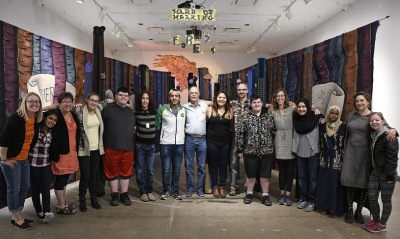Blog
-

Students view hearing world through a different lens in “Deaf Forest” art exhibition.
 9 Oct , 2017
9 Oct , 2017
Students view hearing world through a different lens in “Deaf Forest” art exhibition.
In a downtown Regina art gallery, a dense forest of painted burgundy, brown and blue tree trunks is interlaced with ribbons of text… her … at … eeth … u hav …ha hush … e al … ll do …ut … ff … eir … ils w …a … rvi … nife. ck fell … own and … roke his crow … It’s a struggle to fill in the blanks of these disjointed fairy tale verses: Grandmother, what big teeth you have. Husha husha, we all fall down. Cut off their tails with a carving knife. Jack fell down and broke his crown.
This area of the art installation is called the hard-of-hearing forest, and it’s a metaphor for life as experienced by the students in Thom Collegiate’s deaf and hard of hearing program.
As the artistic collective “Deaf Crows”, 11 high school students created The Deaf Forest, an art exhibition on now at Regina’s Dunlop Art Gallery.
“It’s tough because you struggle with studying and understanding language and missing words,” said Grade 11 student Fatima Nafisa.
Her voice was but a whisper, her hands in constant motion, as teacher Michelle Grodecki interpreted Nafisa’s sign language.
“We’re trying to tell people what’s going on inside our heads,” said Joanne Weber, a teacher who guided the students in the project, along with artists Chrystene Ells and Berny Hi.
“You’re going to see all that confusion,” said Nafisa. “There’s words that are missing, you are going to feel angry and you’re going to be like, ‘What is going on here? Why is that there? I don’t know what that means.’”
The Deaf Forest is an eye-opening exhibition for a hearing person.
The section dubbed the hearing forest opens with jagged black and white trees, signifying a potential for danger and hurt, said Weber, “because of the inability to hear and also the lack of comprehension.”
The trees are trimmed with so-called “dead faces,” blank white masks. Beyond, there is a wall of photos, closeups of hands in pockets, crossed arms and hands blocking mouths.
These are all hindrances for deaf people who read lips, or communicate with the expressive American Sign Language (ASL), a body language using animated facial expressions and hand gestures.
“Part of the ASL grammar involves facial expression,” said Weber, “so when the faces are dead, we lose a lot of information.”
“If you watch hearing people talk to each other, they’ll start a sentence and then they’ll turn and walk away,” said Ells, “and that doesn’t work in the deaf community. You have to finish your sentence while you’re making eye contact.”
“When you’re communicating (with ASL), things just seem so much more alive in your communication,” added fellow artist-in-residence Hi.
“It makes me think maybe even in the hearing world we should be connecting more.”
Weber has struggled all her life as a deaf person in a hearing world.
The students bonded as they began to conceive the Deaf Crows theatre production in 2015, the same year the school division’s three programs for deaf students were amalgamated and centralized at Thom.
Talking about their experiences of bullying, exclusion, sadness and isolation growing up, they realized their shared experiences.
That seed has grown to the point that now the students greet each other at the start of the school day, and ask each other questions.
The last line of the play is “we are not animals anymore.”
“They’re coming out of a state where they almost felt like they were not human,” said Ells, “and now they’re being seen as human beings and they feel like human beings.
“Deaf kids don’t really have that cultural experience of incidental learning,” added Ells: They didn’t grow up hearing their parents’ conversations; they didn’t have an immersive socialization.
“They’re starting to have these understandings of social interactions that they didn’t have.”
Nafisa spent three years in mainstream elementary school classes, after moving to Regina from Bangladesh.
When she entered Grade 9, “I was like, ‘Whoa, this is crazy. All of these students here are deaf?’ I had never known that there were that many deaf people,” said Nafisa. “I started to really feel like I was finding out who I was.”
She started to learn sign language and interact with her classmates.
“Then we realized that all of the students, we all shared the same feelings and the same experiences about what happened growing up with a hearing loss and it just empowered me,” said Nafisa.
“I felt, ‘Wow, I am the same as everyone else, we all have that same experience,’ so I started to understand that it was OK to sign.”
The Deaf Forest began last November as Weber instructed the students to create abstract art, informed by their feelings about being deaf.
Instead of abstract pictures, though, they drew trees. Rocks and rivers too, but mostly trees.
Trees in the hearing forest are black and white and bleak. Those in the hard-of-hearing forest are murky and crowded.
There is but one tree in the area called the deaf forest. It is big and bright, made of quilted fabric, with paper flowers blooming on its multi-coloured branches. It was painstaking to create, involving 10 days of sewing in Weber’s garage.
It’s “an environment where communication is not such a struggle,” said Weber.
Also within the deaf forest, there are drawings of ASL hand signs and splatter paintings by students in the Henry Janzen School elementary program for deaf and hard of hearing students.
The message beneath a colourful crow on the wall reads, “I feel so poetry when I paint my feel.”
It is not grammatically correct English, nor is it ASL phrasing, said Weber, but something between two languages — and a nice sentiment.
“When you have full access, you can come alive,” said Weber. “Here, they can learn.”
Making art has improved the students’ ability to communicate with their families, in part because their projects have opened up a conversation.
“They’re able now to tell their families and their friends how they really feel,” said Weber, who speaks from experience.
“Arts is a passageway, it’s a portal to deeper thinking, to better knowledge,” said Wendy Peart, curator of education and community outreach at the Dunlop Art Gallery.
“It has a way of expressing things that cannot always be said in words.”
The coursework overlaps, with students obtaining credit for English along with art or drama as different curriculum outcomes are met.
“It’s sort of across-the-curriculum approach,” said Weber, and a different approach to deaf education.
Hearing people can learn easily, picking up information in random encounters.
“That’s not how deaf people learn,” added Thomas. “Deaf people are not hearing people that can’t hear very well. We think differently, we learn differently, and we learn mostly through community.”
“We are very much shaped by what we can’t hear,” said Weber. “Our bodies are reacting and responding in different ways; our hearts and our minds are thinking and processing in different ways.”
Weber hopes that The Deaf Forest will open people’s minds about deaf people.
Source: Ashley Martin, Regina Leader-Post (This article has been truncated to express the most salient points with brevity).
Image credit: Troy Fleece/ Regina Leader-Post,(“Deaf Crows”, a group of deaf and hard of hearing students at Thom Collegiate, pose for a group shot at the Dunlop Art Gallery along with their teachers and artists-in-residence).





























































































































































































































































































































































































































































































































































































